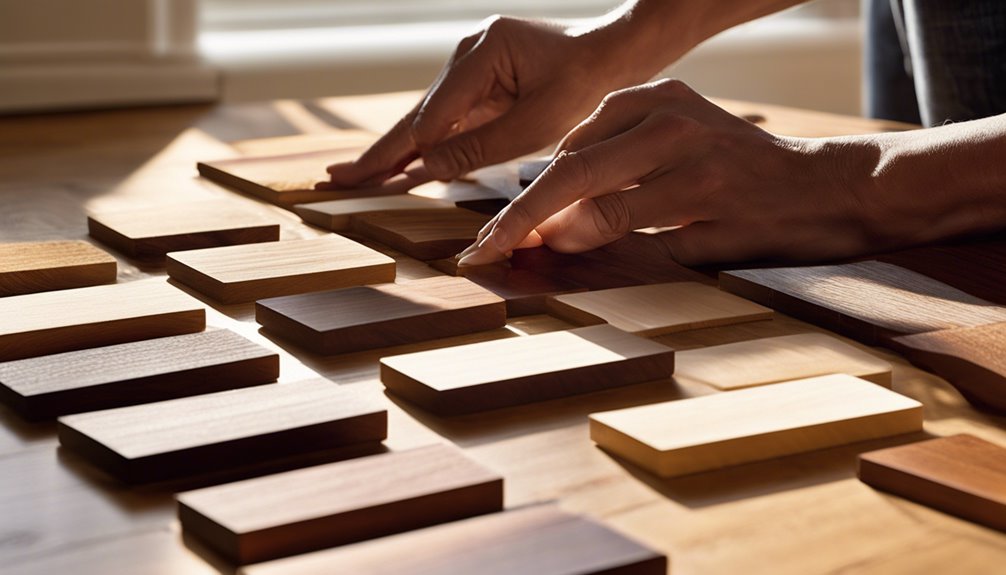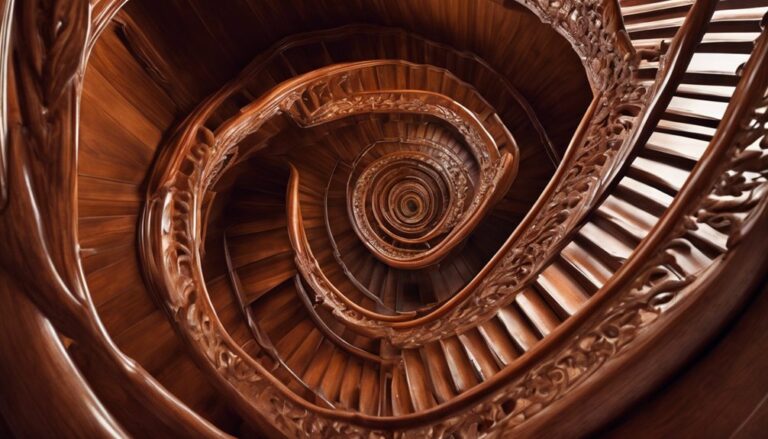To select hardwood flooring, start by evaluating your lifestyle and needs. If you have pets or children, choose durable species like oak or hickory. Set a clear budget that includes installation and potential maintenance costs. Different wood species offer unique aesthetics, so pick one that aligns with your design goals. Don't forget to factor in finish types, as they affect both appearance and upkeep. Finally, consider sourcing wood responsibly to minimize environmental impact. By following these steps, you can make an informed choice that balances beauty and functionality, and there's more to uncover about specifics and options available.
Assess Your Lifestyle
How do you envision your daily life unfolding with your new hardwood flooring? If you have active family activities, consider how the durability of hardwood will support your lifestyle. Engineered hardwood might be a wise choice, as it can withstand the wear from children's play and heavy foot traffic.
Additionally, pet considerations are essential; hardwood can be susceptible to scratches. Opt for a harder wood species like oak or hickory to minimize damage. Regular maintenance, such as cleaning and refinishing, will help maintain its appearance. Think about how easy it will be to clean up after family gatherings or pet messes. Ultimately, evaluating your lifestyle guarantees your flooring choice aligns with your day-to-day needs, offering both beauty and functionality.
Determine Your Budget
Setting a clear budget is essential when choosing hardwood flooring, as costs can vary greatly based on material, finish, and installation methods. Begin your budget planning by researching different hardwood options and their associated prices. Conduct a thorough cost comparison to understand what fits within your financial limits. Don't forget to factor in additional expenses, such as underlayment, trim, and installation fees, which can notably influence your overall expenditure. It's wise to have a cushion in your budget for unexpected costs that may arise during the installation process. By being diligent in your budget planning, you'll have the freedom to select a flooring option that meets both your aesthetic desires and financial constraints, ensuring a rewarding purchase.
Choose the Right Wood Species
After you've established your budget, the next step is to choose the right wood species for your hardwood flooring. Different species offer distinct aesthetics, durability, and maintenance levels. Oak varieties, like red and white oak, are popular for their strength and adaptability, making them suitable for high-traffic areas. If you seek something more unique, consider exotic woods such as Brazilian cherry or teak, which provide rich colors and remarkable durability. Keep in mind that exotic woods tend to be pricier and may require specific care. Ultimately, the right wood species should align with your lifestyle, design preferences, and long-term maintenance goals, ensuring your flooring remains both functional and visually appealing for years to come.
Explore Different Finishes
When choosing hardwood flooring, understanding the types of finishes available is essential for achieving the desired look and durability. Each finish comes with specific maintenance requirements that can affect the long-term care of your flooring. By evaluating these factors, you can make an informed decision that aligns with your lifestyle and aesthetic preferences.
Types of Finishes
While choosing the right finish for your hardwood flooring may seem overwhelming, it is crucial to understand the various options available, as each type can greatly affect the look and durability of your floors. Two popular categories are oil finishes and water-based finishes.
Oil finishes penetrate the wood, enhancing its natural beauty while providing a rich, warm appearance. They require more maintenance but allow for easier spot repairs. On the other hand, water-based finishes dry quickly and offer a more durable, clear coat that resists yellowing over time. They tend to be lower in VOCs, making them environmentally friendly. Ultimately, your choice will depend on your aesthetic preferences, maintenance willingness, and desired performance for your hardwood flooring.
Maintenance Requirements
Understanding the maintenance requirements for your hardwood flooring is essential, especially since different finishes demand varying levels of care. Here's a quick guide to help you maintain your flooring effectively:
- Cleaning Techniques: Use a microfiber mop and a pH-balanced cleaner specific to your finish type. Avoid excessive water to prevent damage.
- Repair Tips: For scratches, consider using a wood filler that matches your floor's color. Minor dings can often be buffed out with a fine-grit sandpaper.
- Periodic Maintenance: Schedule professional refinishing every 3-7 years, depending on wear and tear.
Consider Plank Width and Length
When choosing hardwood flooring, the width and length of the planks can markedly influence both the installation process and the overall aesthetics of your space. Standard plank dimensions typically range from 2 to 12 inches in width, and lengths can vary, affecting how the floor visually expands or contracts a room. Consider how these dimensions will complement your interior design and the effect they'll have on the perceived size of your area.
Standard Plank Dimensions
Standard plank dimensions play an essential role in the overall aesthetic and functionality of hardwood flooring. When selecting your flooring, consider standard sizes and plank variations to guarantee you achieve the desired look and performance. Here are three key aspects to keep in mind:
- Width: Planks typically range from 2 to 8 inches wide, with wider planks creating a more open feel.
- Length: Standard lengths can vary from 1 to 10 feet, affecting installation patterns and visual continuity.
- Thickness: Most hardwood planks are around 3/4 inch thick, providing durability and stability.
Understanding these dimensions will empower you to make informed choices that enhance your space's freedom and character.
Impact on Aesthetics
The choice of plank width and length greatly influences the overall aesthetics of your hardwood flooring. Wider planks can create a more open and spacious feel, making them ideal for larger rooms. Conversely, narrower planks may lend a cozy, intimate vibe, perfect for smaller spaces. Length also plays a critical role; longer planks can visually elongate a room, enhancing flow and design harmony. When selecting your flooring, consider how the plank dimensions interact with your existing color schemes. For example, lighter shades with wider planks can amplify brightness, while darker tones may evoke warmth. Ultimately, balancing plank width and length with your desired aesthetic will help you achieve a cohesive and inviting environment that reflects your personal style.
Evaluate Installation Methods
How do you choose the right installation method for your hardwood flooring? Evaluating installation techniques is vital for achieving a durable and aesthetically pleasing result. Here are three key methods to reflect on:
- Nail-Down: This method is ideal for solid hardwood, providing stability and is suitable for plywood or OSB subfloors.
- Glue-Down: Utilizes flooring adhesives, perfect for engineered wood and concrete substrates, ensuring a strong bond.
- Floating: This technique allows the planks to expand and contract freely, making it a great option for DIY enthusiasts.
Each method has its unique benefits and requirements, so it's important to evaluate your specific needs and preferences before making a decision. Choose wisely to enjoy your beautiful hardwood floor for years to come!
Understand Maintenance Requirements
Maintaining hardwood flooring involves understanding several key requirements to keep it looking pristine and prolong its lifespan. Effective cleaning techniques and long-term care are essential for preserving your investment. Regular sweeping or vacuuming prevents dirt buildup, while damp mopping with a recommended cleaner can eliminate spills and stains.
| Task | Frequency |
|---|---|
| Dusting/Sweeping | Weekly |
| Damp Mopping | Monthly |
| Deep Cleaning | Every 6-12 months |
Review Environmental Impact
Choosing hardwood flooring not only involves considerations of aesthetics and maintenance but also requires an awareness of its environmental impact. To make an informed choice, consider the following factors:
- Sustainable Sourcing: Look for wood harvested from responsibly managed forests, ensuring minimal ecological disruption.
- Environmental Certifications: Seek certifications like FSC (Forest Stewardship Council) or PEFC (Programme for the Endorsement of Forest Certification) that confirm sustainable practices.
- Life Cycle Assessment: Evaluate the flooring's entire life cycle, from production to disposal, to understand its overall environmental footprint.
Frequently Asked Questions
How Long Does Hardwood Flooring Typically Last?
Think of hardwood flooring as a sturdy oak tree, standing tall against the elements. Typically, hardwood lifespan ranges from 20 to 100 years, depending on the species and maintenance. Its durability is a demonstration of its natural resilience. With proper care—like regular cleaning and refinishing—you can extend its life considerably. Choosing wisely now means you'll enjoy the beauty and strength of your flooring for decades, creating a lasting foundation for your home.
Can Hardwood Floors Be Refinished Multiple Times?
Yes, hardwood floors can be refinished multiple times, depending on the thickness of the wood. Utilizing effective refinishing techniques can greatly extend your flooring's lifespan. Typically, you can refinish solid hardwood floors every 7 to 10 years, while engineered wood may allow for fewer refinishes. Each time you refinish, you're not just restoring appearance but also enhancing durability, giving you the freedom to enjoy your beautiful floors for years to come.
What Is the Best Way to Clean Hardwood Floors?
To keep your hardwood floors looking great, focus on using appropriate cleaning products. Avoid harsh chemicals that can damage the finish. Instead, opt for a pH-neutral cleaner specifically designed for wood. Regular maintenance tips include sweeping or vacuuming to remove dirt and debris, and mopping with a damp cloth. Always dry the floor afterward to prevent moisture damage. Following these steps guarantees your hardwood stays beautiful and lasts longer.
Are There Any Warranties on Hardwood Flooring?
Imagine your hardwood floors as the foundation of your home's elegance. When it comes to warranties, it's essential to understand the warranty coverage and warranty duration. Most manufacturers offer warranties ranging from 15 to 50 years, depending on the product. Be sure to read the fine print, as some warranties cover defects while others might include wear and tear. Knowing these details gives you the freedom to choose flooring that fits your lifestyle.
How Does Humidity Affect Hardwood Flooring?
Humidity affects hardwood flooring markedly. High humidity can cause wood to absorb moisture, leading to expansion, warping, and gaps between planks. Conversely, low humidity may result in contraction, creating cracks. To mitigate these humidity effects, it's essential to maintain proper moisture control through humidifiers or dehumidifiers, depending on your environment. Regularly monitoring indoor humidity levels can help preserve your flooring's integrity, ensuring it remains beautiful and functional for years to come.




